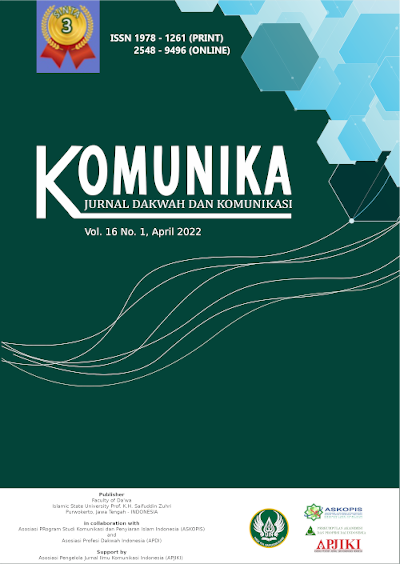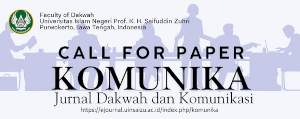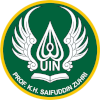Communication Organization of "Salima Mazari" Governor Charkint Afghanistan on the Conflict Against the Taliban
DOI:
https://doi.org/10.24090/komunika.v16i1.5954Keywords:
Communication Management, Leadership, AfghanistanAbstract
The creation of a harmonious relationship within an organization becomes the most crucial part of the process of achieving organizational goals. Cooperative relationships in an organization begin with communication and interaction between members, in addition to having an attitude of responsibility, honesty, broad-mindedness, and the courage to make decisions. Furthermore, a leader in an organization must maintain good communication skills. A similar case happened under the leadership of Salima Mazari as Governor of Charkint Afghanistan during the conflict in Afghanistan with the Taliban group. As a leader, Salima must be competent to defend her citizens and survive. Thus, communication makes it essential for Salima to communicate with government officials and the community. This study aimed to determine the communication pattern of Salima Mazari as a leader in Charkint, Afghanistan, an area that is being hit by a prolonged political conflict. The data collection method used in this research is a literature study with secondary data that discusses the managerial and leadership style of Salima Mazari as the Governor of Charkint Afghanistan during the conflict that hit Afghanistan by analyzing his motivation and leadership style. The theory used is organizational communication theory. Based on the results of this study, Salima Mazari tends to have a managerial and leadership kind of "Inviting Participants."Downloads
References
Burke johnson & larry christensen. (2012). Educational research fourth edition quantitative, qualitative, and mixed approaches. Sage Publications Inc: University of south Alabama
Devito , Joseph .1978. Communicology: An Introduction to the Study of Communication, New York: Harper and Row Publisher
Embun, B. 2012. “Banjir Embun.” Retrieved (https://www.banjirembun.com/2012/04/).
Evi Zahara. 2018. “Peranan Komunikasi Organisasi Pimpinan Organisasi.” Peranan Komunikasi Organisasi Bagi Pimpinan Organisasi 1829–7463(April).
Gunawan, Rain, andAhmad Toni. 2019. “Masyarakat Dan Protokol Dalam Lembaga Negara Di Era Pandemi Covid-2019.”
Hamid, Farid. (2019). Pendekatan fenomenologi (suatu ranah penelitian kualitatif)
Helaluddin. (2018). Mengenal Lebih Dekat Dengan Pendekatan Fenomenologi: Sebuah Penelitian Kualitatif. Jurnal Uin Sultan MaulananHasanuddin, Banten
Littlejohn, Stephen W. 1992.Theories of Human Communication, Fourth Edition, Belmont California, Wadsworth Publishing Company
Manalullaili. (2015). Komunikasi Efektif Bagi Seorang Pemimpin. Wardah, 13(2), 165–172.
Maulani, Z. A. 2002. “Perang Afghanistan: Perang Menegakkan Hegemoni Amerika Di Asia Tengah.”
Mulyana, A., Hamid, F., Mansur, S., & Susilawati, S. (2019). Kepemimpinan efektif melalui kompetensi komunikasi di Media Nusantara Citra Group. Jurnal Kajian Komunikasi, 7(2), 184. https://doi.org/10.24198/jkk.v7i2.23853
Nasukah, B., Sulistyorini, S., & Winarti, E. (2020). Peran Komunikasi Efektif Pemimpin Dalam Meningkatkan Kinerja Institusi. AL-TANZIM: Jurnal Manajemen Pendidikan Islam, 4(1), 81–93. https://doi.org/10.33650/al-tanzim.v4i1.899
Pace, R. W., & Faules, D. F. (2001). Komunikasi Organisasi: strategi menibgkatkan kinerja perusahaan (D. Mulyana (ed.)). ROSDA.
Rostami-Povey, E. (2014). Afghan Women: Resistance and Struggle in Afghanistan and diasporic communities.
Simamora, R. H. (2020). Pelatihan Komunikasi Efektif untuk Meningkatkan Efikasi diri Perawat dalam Pelaksanaan Identifikasi Pasien. Jurnal Ilmiah Kesehatan Masyarakat, 12(1), 49–54.
Saryono. (2010). Metode PenelitianKualitatif. Bandung: PT. Alfabeta
Susanto, E. H. (2013). Komunikasi Politik: Pesan, Kepemimpinan dan Khalayak.
Sugiyono. (2011). Metode Penelitian Kuantitatif, Kualitatif dan R&D. Bandung : PT. Alfabeta
Teherani A, Martimianakis T, Stenfors-Hayes T, Wadhwa A, Varpio L. (2015). Choosing A Qualitative Research Approach. J Grad Med Educ
Zuwirna. (2016). Komunikasi Yang Efektif. E-TECH, 1(1), 1–8.

Downloads
Published
Issue
Section
License
Copyright (c) 2022 Wuri Annisafitri, Ahmad Toni

This work is licensed under a Creative Commons Attribution-ShareAlike 4.0 International License.
Authors who publish with this journal agree to the following terms:
- Authors retain copyright and grant the journal right of first publication with the work simultaneously licensed under a Creative Commons Attribution-ShareAlike 4.0 International License that allows others to share the work with an acknowledgement of the work's authorship and initial publication in this journal.
- Authors are able to enter into separate, additional contractual arrangements for the non-exclusive distribution of the journal's published version of the work (e.g., post it to an institutional repository or publish it in a book), with an acknowledgement of its initial publication in this journal.
- Authors are permitted and encouraged to post their work online (e.g., in institutional repositories or on their website) prior to and during the submission process, as it can lead to productive exchanges, as well as earlier and greater citation of published work (See The Effect of Open Access).
























